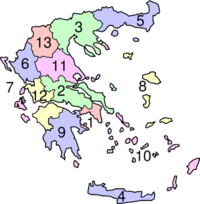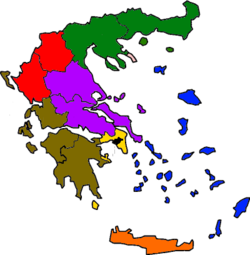- Modern regions of Greece
-
Not to be confused with Traditional geographic divisions of Greece.
Greece 
This article is part of the series:
Politics and government of
GreeceConstitutionParliament- Parliament
- Speaker
- Philippos Petsalnikos
- Presidium
- Conference of Presidents
- Parliamentary Committees
- Speaker
GovernmentJudiciary- Administrative divisions
- Peripheries
- Peripheral units
- Municipalities
Elections- Elections:
- 2006 (local)
- 2007 (legislative)
- 2009 (European)
- 2009 (legislative)
- 2010 (local)
- Political parties
- Constituencies
The current official regional administrative divisions of Greece (Greek: περιφέρειες) were instituted in 1987. Although best translated into English as "regions", the transcription peripheries is sometimes used, perhaps to distinguish them from the traditional regions which they replaced. The English word 'periphery' is derived from the Greek: περιφέρεια, which in Greek (but not in English) also means 'region'. There are 13 regions (nine on the mainland and four island groups), which (until 2010) were further subdivided into the now abolished 54 prefectures.
Traditionally, Greece was divided into 10 regions, which are still sometimes referred to in popular discourse. These are not to be confused with the new regions, even though the latter are largely based on the former, because there are areas of divergence. For example, the new region of the Peloponnese does not include all of the landmass traditionally known as the Peloponnese; the excluded part now finds itself in the region of Western Greece.
The first seven regions were established by the then-ruling military regime in 1971, but they were abolished after the fall of Georgios Papadopoulos in November 1973. The current regions were created by Law 1622/1986 and Presidential Decree 51/1987, and were conceived as an auxiliary regional level of the central government. With ongoing decentralization, they were accorded more powers in the 1997 Kapodistrias reform of local and regional government, and were finally transformed into fully separate entities by the 2010 Kallikratis plan (Law 3852/2010), which entered into effect on 1 January 2011. The government-appointed general secretary was replaced with a popularly elected regional governor and a regional council with 5-year terms, while many powers of the abolished prefectures were transferred to the regions. As regional organs of the central government, the new regions were in turn replaced by seven decentralized administrations, which group from one to three regions under a government-appointed general secretary.
- Attica / Αττική
- Central Greece / Στερεά Ελλάδα
- Central Macedonia / Κεντρική Μακεδονία
- Crete / Κρήτη
- East Macedonia and Thrace / Ανατολική Μακεδονία και Θράκη
- Epirus / Ήπειρος
- Ionian Islands / Ιόνια νησιά
- North Aegean / Βόρειο Αιγαίο
- Peloponnese / Πελοπόννησος
- South Aegean / Νότιο Αιγαίο
- Thessaly / Θεσσαλία
- West Greece / Δυτική Ελλάδα
- West Macedonia / Δυτική Μακεδονία
Bordering the region of Central Macedonia there is one autonomous region, Mount Athos (Agion Oros, or "Holy Mountain"), a monastic community under Greek sovereignty. It is located on the easternmost of the three large peninsulas jutting into the Aegean from the Chalcidice Peninsula.
Through the administrative reform of 2011, known as the Kallikratis plan, seven new administrative divisions (διοικήσεις) have been created:
See also
- ISO 3166-2:GR
Template:Modern regions of Greece
First-level administrative divisions in Europe Sovereign
statesAlbania · Andorra · Armenia2 · Austria · Azerbaijan3 · Belarus · Belgium · Bosnia and Herzegovina · Bulgaria · Croatia · Cyprus2 · Czech Republic · Denmark · Estonia · Finland · France1 · Georgia3 · Germany · Greece · Hungary · Iceland · Ireland · Italy · Kazakhstan2 · Latvia · Liechtenstein · Lithuania · Luxembourg · Republic of Macedonia · Malta · Moldova · Monaco · Montenegro · Netherlands · Norway · Poland · Portugal · Romania · Russia1 · San Marino · Serbia · Slovakia · Slovenia · Spain · Sweden · Switzerland · Turkey1 · Ukraine · United Kingdom
States with limited
recognitionAbkhazia3 · Kosovo · Northern Cyprus2 · South Ossetia3
1 Has part of its territory outside Europe. 2 Considered European for cultural, political and historical reasons but is geographically in West Asia. 3 Partially or entirely in Asia, depending on the definition of the border.Categories:- Modern regions of Greece
- Subdivisions of Greece
- Lists of country subdivisions
- Country subdivisions of Europe
- First-level administrative country subdivisions
- Greece-related lists
- Parliament
Wikimedia Foundation. 2010.


